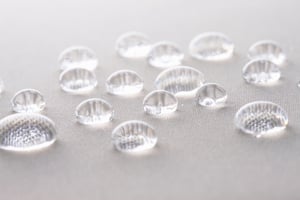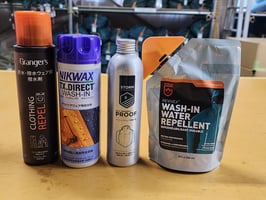Surprisingly few people can properly explain the difference between waterproofing and water...
The Scientific Difference Between Waterproof and Water-Repellent: Essential Knowledge You Might Not Know
Introduction
Have you ever wondered about the difference between waterproof and water-repellent products? You're not alone. Recently, Mr. Sato, an outdoor enthusiast, purchased an expensive rain jacket at an outdoor shop. The salesperson explained that "this product has high-performance waterproof and water-repellent treatments," which made him wonder: "Aren't waterproof and water-repellent the same thing?"
This confusion is incredibly common. Even outdoor shops and home improvement centers sometimes sell products with only water-repellent effects as "waterproof sprays." This confusion appears on many websites as well, where incorrect explanations are widespread.
In this blog post, I'll explain the scientific differences between waterproof and water-repellent properties using concrete examples. I'll also touch on the concept of "water resistance."
Waterproof vs. Water-Repellent: Completely Different Physical Phenomena
To put it simply, waterproof and water-repellent are completely different physical phenomena. They're not related in terms of strength, with water-repellent being "weaker waterproofing." They represent fundamentally different properties.
What is Waterproof?
Waterproof refers to the function of preventing water from passing through a material. It literally means "defending against water."
For example, when you spill water from a plastic bottle onto dry soil, the water soaks into the ground. This happens because the ground has no waterproof function. On the other hand, if you spill the same water onto a plastic bag, the water doesn't pass through but pools on top. This is the basic property of being "waterproof."
Concrete example: Mr. Yamamoto (35) was caught in a sudden downpour while hiking. His ordinary windbreaker initially repelled water, but after a while, the fabric absorbed water, and his clothes underneath got wet. However, his friend Mr. Takahashi's waterproof rain jacket appeared to be absorbing water on the surface, but even after two hours of rain, the inside remained completely dry. This is because Mr. Takahashi's jacket was coated with a special waterproof membrane that prevented water molecules from passing through.
Waterproof performance is typically measured by how much water pressure it can withstand. Expressions like "1000mm waterproof performance" are common. The higher the number, the more water pressure (strong rain or submersion) the material can withstand.
What is Water-Repellent?
Water-repellent describes the phenomenon of "repelling water." This is a completely different physical phenomenon from being waterproof.
The essence of water repellency actually lies in "the nature of water itself." Without any external forces, water tends to form a sphere. Many people have seen images of water droplets in space forming perfect spheres. This is water's natural state.
However, on Earth, when water contacts a surface, attractive forces work between water and that surface. If these forces are strong, the water spreads out (hydrophilic), and if weak, the water remains rounded and rolls off (hydrophobic or water-repellent).
Concrete example: Mr. Tanaka (28) purchased a new car and had "glass coating" applied at the dealership. On rainy days, he noticed an interesting phenomenon. On the coated body of the car, raindrops maintained beautiful spherical shapes while rolling off. In contrast, on the uncoated headlight portions, water spread out into a film. This demonstrates how the same rainwater behaves entirely differently depending on the surface it contacts. On water-repellent surfaces, the attractive force between water and the surface is weak, so water maintains its spherical shape due to its surface tension.
Water repellency is measured by the "contact angle." The larger the angle that a water droplet makes with a surface, the higher the water repellency. Generally, angles greater than 90° are considered "water-repellent." When the contact angle exceeds 150°, it may be called "super water-repellent."
What is Water-Resistant?
Water resistance broadly refers to the property of "being resistant to the adverse effects of water." Unlike waterproof or water-repellent, it doesn't completely prevent or repel water but indicates a state where something can withstand a certain amount of water.
Specifically, water resistance has the following characteristics:
- Broad concept: It refers to a wider range of conditions than waterproofing and indicates some resistance to water. It's a state where something can handle everyday water exposure but isn't completely waterproof.
- Product examples: "Water-resistant watches" can withstand handwashing or rain but aren't suitable for swimming or underwater use.
- Technical standards: For devices, there's the IEC standard IPX (Ingress Protection) rating, ranging from IPX0 to IPX8. The higher the number, the greater the water resistance.
- For clothing: Jackets made with waterproof fabric but without seam tape on the seams might be described as "water-resistant" rather than "waterproof."
- For cosmetics: "Water resistance" in cosmetics indicates whether they can maintain their function when exposed to water.
Water resistance is not a clearly defined physical phenomenon like waterproof or water-repellent but rather a relative concept that indicates "to what extent something can withstand water" from a more practical perspective.
Testing the Difference Between Waterproof and Water-Repellent
Since it can be difficult to understand through words alone, here's a simple experiment you can try at home to confirm the difference.
What you'll need:
- Plastic wrap
- Cloth (like a dishcloth)
- Water-repellent spray
- Dropper or 1 teaspoon of water
Experiment procedure:
- Place plastic wrap and cloth side by side on a table
- Spray water-repellent spray on only half of the cloth and let it dry
- Drop water onto each surface
Results:
- Water on plastic wrap: Doesn't spread, remains as round droplets (water-repellent), and doesn't leak through (waterproof)
- Water on regular cloth: Quickly absorbed and leaks through to wet the table (not water-repellent, not waterproof)
- Water on water-repellent treated cloth: Doesn't spread on the cloth, remains as round droplets (water-repellent). However, if pressed firmly, water leaks through to wet the table (not waterproof)
From this experiment, you can see that waterproof and water-repellent are separate properties. Plastic wrap is both waterproof and water-repellent, but cloth treated with water-repellent spray is water-repellent without being waterproof.
The Often Misunderstood Concept of "Water Resistance"
The term "water resistance" is also frequently used but differs from both waterproof and water-repellent properties.
Water resistance broadly means being able to withstand water (being less susceptible to adverse effects from water). For example, the "water-resistant function" of electronic devices often means they can withstand small amounts of water droplets or humidity but aren't completely waterproof in many cases.
Concrete example: Mr. Sasaki (42) purchased a "water-resistant watch." The instructions stated, "Resists water exposure in daily life," but after swimming in a pool, he noticed water had entered the watch. This is a typical example of water-resistant ≠ waterproof. Water-resistant watches can withstand handwashing or rain but aren't suitable for swimming or underwater use. A higher-grade waterproof watch with IPX7 or IPX8 rating would withstand swimming or diving.
Practical Comparison: Waterproof and Water-Repellent in Outdoor Products
Let's consider the differences between waterproof and water-repellent using outdoor products as examples.
Rain Gear
1. Fully Waterproof Rain Gear
- Features: Uses a waterproof membrane, and seams are sealed with tape
- Water repellency: Usually has water-repellent treatment on the surface (water droplets roll off)
- Waterproof performance: Withstands high water pressure (about 10,000mm to 20,000mm)
- Suitable situations: Extended periods of rain, mountaineering in severe weather
- Drawbacks: Often has poorer breathability, more likely to cause sweating
2. Windbreaker with Only Water-Repellent Treatment
- Features: Has water-repellent treatment but no waterproof membrane
- Water repellency: Yes (water droplets form spheres and roll off)
- Waterproof performance: None or low (can withstand temporary light rain but not sustained rain or water pressure)
- Suitable situations: Brief light rain, drizzle, wind protection
- Advantages: Lightweight, often better breathability, compact and easy to carry
Concrete example: Mr. Kobayashi (30) went hiking with a friend. With a forecast predicting light rain, Mr. Kobayashi chose a lightweight water-repellent windbreaker, while his friend wore a fully waterproof Gore-Tex jacket. During the hike, they were caught in unexpected heavy rain. After about 20 minutes, the water-repellent effect of Mr. Kobayashi's windbreaker diminished, and it began to absorb water. Meanwhile, his friend's Gore-Tex jacket's water-repellent effect also diminished after three hours of rain, but it kept the interior completely dry. This demonstrates that water-repellent treatment alone cannot handle sustained rain.
Tents
1. Waterproof Tents
- Flysheet (outer cover) has waterproof coating, and the groundsheet laid on the ground is also waterproof
- Seams are treated with seam tape
- Generally has waterproof performance of 2,000mm water column or higher
2. Cotton Tents or Tents Without Seam Tape
- Cotton tents have water-repellent treatment on cotton, and cotton fibers swell to prevent water penetration
- Tents without seam tape have only water-repellent treatment on the flysheet, and the seams are folded to provide simple waterproofing
- Can handle light rain or morning dew but unsuitable for heavy rain
- Usually intended for use in fair weather only (with at most temporary rain)
Maintenance and Restoration Methods for Waterproof and Water-Repellent Properties
Since waterproof and water-repellent are different properties, they each have appropriate maintenance methods.
Maintaining Waterproof Properties
- Thoroughly dry after use to prevent degradation of seam tape or waterproof coating (tents)
- Handle gently when washing to avoid damaging the waterproof membrane
- If waterproof tape peels off, repair with a specialized repair kit
Restoring Water-Repellent Properties
- Wash to remove dirt (dirt reduces water repellency)
- Warm in a dryer or treat with an iron on low heat (heat treatment can restore water repellency)
- Re-treat with water-repellent spray or water-repellent agent, or request professional treatment
Concrete example: Mr. Suzuki (39) noticed that the water repellency of his rain jacket, which he had used for three seasons, had decreased. He first washed it with a special detergent, completely dried it, then heated it in a dryer for 20 minutes. When water repellency didn't recover, he re-treated it with a commercially available water-repellent agent. After retreatment, rainwater beautifully beaded up and rolled off, indicating restored water repellency. However, there was an area on the shoulder where the seam tape had peeled off, causing water to penetrate (reduced waterproofing), so he reapplied waterproof tape there.
Conclusion: The Importance of Understanding the Difference Between Waterproof and Water-Repellent
Waterproof and water-repellent are completely different physical phenomena:
- Waterproof: Function that prevents water from passing through
- Water-repellent: Phenomenon that repels water, forming round water droplets
- Water-resistant: Broadly, property of being less susceptible to adverse effects from water
Understanding these differences allows you to choose products suitable for your outdoor activities. Some situations require complete waterproofing, while lightweight water-repellent treatment is sufficient in others.
For example, mountaineering requires fully waterproof rain gear, but a water-repellent windbreaker may be sufficient for light rain in urban areas.
When purchasing products, accurately understand the "waterproof" and "water-repellent" labels and make appropriate choices for your needs. Above all, remember that these properties can be maintained for a long time with proper care.



.jpg?height=200&name=vol03(1).jpg)